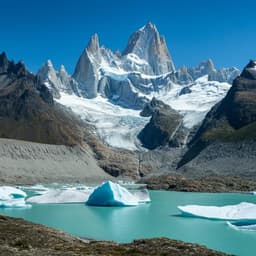
Earth Sciences
Rapid retreat of Thwaites Glacier in the pre-satellite era
A. G. C. Graham, A. Wåhlin, et al.
Explore the groundbreaking research conducted by Alastair G. C. Graham and colleagues, which uncovers the rapid retreat of Thwaites Glacier and its implications for rising sea levels. This study reveals a surprising retreat rate that could reshape our understanding of Antarctic dynamics.
~3 min • Beginner • English
Introduction
Thwaites Glacier, West Antarctica’s second largest marine ice stream, is a major uncertainty in sea-level projections due to its retrograde bed that deepens to more than 2 km below sea level and the delivery of warm Circumpolar Deep Water into its ice-shelf cavity, which enhances basal melting. Since 2011, satellite observations reveal acceleration, thinning and widening of its fast-flowing trunk, and spatially variable grounding-line retreat linked to reduced buttressing from weakening pinning points at the Eastern Ice Shelf and the Thwaites Glacier Tongue. As stabilizing contacts lessen, future retreat becomes increasingly governed by grounding-zone processes and their interaction with sea-floor topography. Presently, Thwaites is grounded on prominent sea-floor ridges, but the processes at marine ice-stream margins are poorly resolved, complicating predictions of retreat rates and mechanisms. Constraining pre-satellite-era behaviour is essential because present changes partly reflect adjustments to past imbalance, yet direct grounding-line observations extend back only 30–40 years. Although deglacial history since the Last Glacial Maximum is relatively well constrained, there is a paucity of data for the last 10,000 years and especially the last few centuries for Thwaites. This study targets a former grounding-zone promontory (“the bump”) mapped offshore of Thwaites that is geologically analogous to the modern grounding zone, to reconstruct subannual to daily rates and mechanisms of retreat prior to direct observations.
Literature Review
Previous work has documented widespread, rapid grounding-line retreat across Amundsen Sea glaciers from 1992–2011 and heterogeneous retreat and melt patterns at Thwaites since 2011. Weakening of pinning points at the Thwaites Eastern Ice Shelf and the Thwaites Glacier Tongue reduced buttressing, fostering retreat and dynamic change. Geological and geophysical mapping offshore revealed former grounding zones and sea-floor promontories analogous to present configurations, suggesting sites where past processes can be inferred. Studies of grounding-zone wedges and delicate submarine landforms (notably in the Antarctic Peninsula and Weddell Sea) have demonstrated the potential to resolve exceptionally fast retreat rates and even subannual changes, but those settings were influenced by deglacial sea-level rise and are not direct analogues for near-future West Antarctic conditions. Satellite monitoring since the 1990s improved temporal resolution, yet reconstructing annual to daily retreat rates for historical periods remained elusive. Theoretical and modelling studies highlight the key roles of sea-floor topography, tidal flexure, grounding-zone width, and basal sedimentation in stabilizing or destabilizing grounding lines, and suggest the possibility of rapid, non-linear retreat phases superimposed on long-term trends.
Methodology
Study site and survey: The team investigated an isolated sea-floor promontory (“the bump”, ~630–670 m water depth) at the southwest corner of the remnant Thwaites Glacier Tongue, within tributary trough T2 that channels modified Circumpolar Deep Water. The bump is deeper than modern iceberg keel depths, minimizing post-retreat disturbance. It is flanked by ~800 m-deep subtroughs. An autonomous underwater vehicle (AUV; Kongsberg HUGIN, 6,000 m rated) was deployed at the Thwaites ice front to collect high-resolution geophysical data.
AUV mission and sensors: Mission 009 was conducted from RV Nathaniel B. Palmer during cruise NBP19-02 (Jan–Mar 2019). The AUV was launched at 22:07 UTC on 28 Feb 2019 (75° 04.21′ S, 106° 58.89′ W) and recovered at 15:33 UTC on 1 Mar 2019 (75° 05.409′ S, 107° 10.925′ W), total 17 h 26 min on mission. Flight altitude: 50–95 m above seabed. Sensors included a single-head Kongsberg EM2040 multibeam echosounder and a dual-frequency Edgetech 2205 sidescan sonar. Sidescan high-frequency channel: 400 kHz, processed with 0.05 m pixels.
Navigation and processing: Navigation used an onboard INS, Doppler velocity log, and two 12 kHz UTP (CNODES) beacons. Due to noise in the first UTP, post-cruise processing in Kongsberg NavLab removed first-UTP fixes; the AUV navigated by dead reckoning with GPS until the second UTP, then UTP-INS thereafter. Loops were removed and a static shift of 95 m at 130° applied. Multibeam data were processed in MB-System: extraction of nav/attitude, conversion, ping editing, and gridding. Primary analysis grid: 1.5 m cell size (Gaussian-weighted mean; spline fill up to six cells). A refined 0.7 m grid was produced post-processed for visualization and verification. Approximately 13 km² were mapped over ~19 h of track lines.
Geomorphological mapping and landform extraction: Landforms were mapped in GIS from multibeam grids and hillshades, supported by sidescan images, at scales 1:500 to 1:5,000. Classification was geometry-based. For rib geometry, profiles along rib sets were sampled at 0.1 m spacing, detrended (least-squares), smoothed (100-point adjacent average removed long wavelengths), and baseline-adjusted by digitizing trough nodes and interpolating. A peak analysis identified crest heights (amplitudes) and peak-to-peak spacings.
Tidal analysis: Predicted tidal amplitudes were extracted from the TPXO-9 global tidal model (Oregon State University) at 108° W, 74° S, including eight primary, two long-period, and five non-linear constituents. The time window was 22 Mar–4 Sep 2020 at hourly resolution. A 24-point percentile filter (99th percentile) emphasized daily peak tidal heights, highlighting the fortnightly spring-neap cycle. Fast Fourier transforms (FFT, Hanning window) were applied to rib amplitude and spacing series and to the filtered tide series to compare dominant frequencies. Coherence between rib geometries and tides was assessed; R² was computed for amplitude variability vs. daily tidal heights.
Supplementary observations: Additional mapping identified three grounding-zone fronts (GZ1–GZ3), subglacial lineations, meltwater channels (e.g., a 6 m deep, 75 m wide channel terminating in an ice-contact fan), and gullies aligned with former grounding-line positions.
Key Findings
• The bump preserves a former grounding-zone system of Thwaites Glacier, including three successive grounding-zone ramps (GZ1–GZ3) expressed as 0.5–2 m-high, steep, tortuous ramps marking till-sheet edges and stepwise southward retreat.
• Widespread, subtle transverse ribbed landforms overprint the most recent grounding surface (GZ3). Over 1,500 individual ribs were mapped; 70% are <20 cm high, with overall amplitudes 0.1–0.7 m and typical spacings 6.6–7.6 m (range ~1.6–10.5 m).
• The longest continuous rib series (164 ribs over 1,050 m) shows a clear 13–15-ridge amplitude modulation cycle repeating ten times. FFT periodograms of rib amplitude and spacing reveal dominant periodicities matching the modeled spring–neap tidal cycle (14.33 days), and coherence with daily tidal heights (R² = 0.57).
• Rib geometry indicates daily formation tied to tidal flexure: grounding at low tide forms a ridge by settling and sediment extrusion; during high tide the grounding line lifts and migrates inland; at the next low tide, a new ridge forms. This mechanism implies many metres of retreat per day.
• Derived daily grounding-line migration rates vary from ~4 m/day during neap tides to ~8 m/day during spring tides. Over a 5.5-month interval, mean retreat rates across the bump accelerated from 2.12 to 2.3 km/yr (≈8% increase upstream), exceeding satellite-era rates on nearby sectors (0.6–0.8 km/yr, 2011–2017) and typical Amundsen Sea values (≤1–2 km/yr), and comparable in extremity only to rare short-lived events (e.g., Pope Glacier >11 km/yr in 2017).
• Estimated heat flux exceeding ~600 W m⁻² is required to sustain the inferred daily melt/retreat, consistent with delivery by ~1.2 °C water above in situ freezing with a fully turbulent ice–ocean boundary layer (comparable to 300–900 W m⁻²).
• Ribs preferentially occur where sea-floor and ice-base slopes are very low, indicative of ice-plain conditions near buoyancy. Low gradients facilitate rapid, tidally modulated grounding-line migration and preserve a ‘pure’ tidal signal in the deposits.
• Additional geomorphic evidence (lineations, meltwater channels, ice-contact fan) confirms fully grounded conditions with active sediment transport and subglacial hydrology during retreat across the bump.
Discussion
The findings directly address how fast and by what mechanisms Thwaites Glacier’s grounding line can retreat when perched on bathymetric highs. The discovery of daily rib formation with a 14-day spring–neap modulation reveals tidal flexure as a first-order control on grounding-line migration over low-gradient ice plains. The reconstructed retreat rates (>2.1 km/yr over 5.5 months, with day-to-day variability) demonstrate that Thwaites can undergo sustained pulses of rapid retreat that far exceed commonly reported decadal averages. This supports the concept that long-term mean rates may mask transient but dynamically important accelerations.
The geomorphic record indicates that as the grounding line detaches from stabilizing sea-floor ridges, the grounding zone can broaden and become more sensitive to ocean forcing and tidal mixing within a narrow cavity, enhancing basal melt and facilitating rapid, tidally modulated inland migration. Erosional flattening of sea-bed highs during periods of grounding likely preconditions the system by promoting ice-plain development, which coupled models suggest is associated with greater susceptibility to fast retreat. Given that Thwaites’s present grounding line now occupies similar-depth ridges, analogous rapid retreat pulses could initiate within months if contact with high points diminishes. Incorporating tidal migration physics, grounding-zone width effects, and sediment-bed evolution into coupled ice–ocean models is therefore crucial for realistic projections of Thwaites’s future contribution to sea-level rise.
Conclusion
High-resolution AUV bathymetry and sidescan sonar on a former grounding-zone promontory reveal thousands of subtle, transverse ribs that record daily, tidally modulated grounding-line retreat of Thwaites Glacier over approximately 5.5 months, with rates exceeding 2.1–2.3 km/yr. The 13–15-ridge amplitude cycles match the spring–neap tidal periodicity and demonstrate strong tidal control on grounding-line motion over low-slope ice plains. This geological archive provides unprecedented subdaily to daily resolution of grounding-line behavior in the pre-satellite era, showing that Thwaites has experienced sustained pulses of rapid retreat in the last few centuries. Because the modern grounding line is stabilized on similar bathymetric highs, comparable rapid pulses are likely as the glacier ungrounds from these points, with significant implications for near-term sea-level rise.
Future research should (1) directly date the rib deposits to constrain retreat timing and pace, (2) expand high-resolution seabed mapping to other former and modern grounding zones to assess spatial variability, (3) integrate tidal migration and ice-plain processes and bed evolution into coupled ice–ocean models, and (4) quantify ocean-driven heat fluxes and tidal mixing within grounding zones to better predict triggers and magnitudes of rapid retreat phases.
Limitations
• Chronology is not directly constrained: the ribs’ absolute ages remain uncertain without sampling and dating; inferred pre-1950s to centuries-old ages rely on assumptions about past retreat rates and positions.
• Spatial coverage is limited (~13 km² around a single promontory), and ribs are not ubiquitous even within the study area, occurring preferentially over very low slopes; thus, results may not generalize to all bed settings.
• Retreat rate estimates assume one rib formed per tidal day and rely on present-day tidal model periodicities applied as analogues; although coherence is strong, uncertainties remain in exact historical tidal forcing and ocean conditions.
• Heat-flux estimates are order-of-magnitude calculations contingent on assumptions about boundary-layer turbulence and water properties.
• Navigation required post-processing and application of a static shift; while internal consistency is high, small positional uncertainties remain.
• The study infers processes from geomorphic imprints without direct contemporaneous observations of ice–ocean interactions at the time of rib formation.
Related Publications
Explore these studies to deepen your understanding of the subject.







